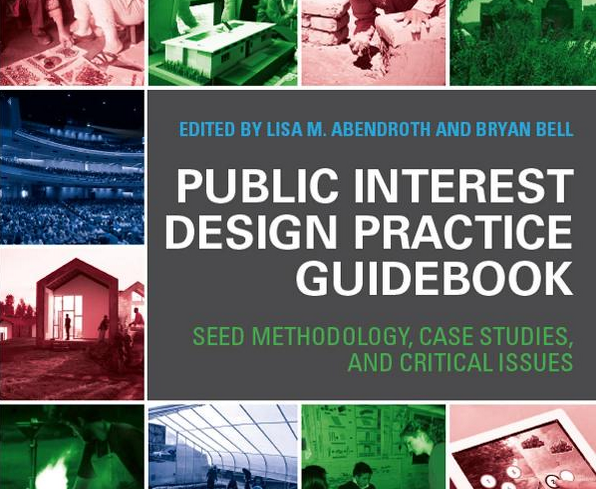Summer is a great time to catch up on good reads. For those interested in socially-oriented architecture, urbanism and design, we’ve put together a roundup of recent publications recommended by some of our faculty members, who are always on top of the latest literature pertaining to the field of development and design. For more, check out our previous list, Top 10 Books on Reconstruction and Development.
 Public Interest Design Practice Guidebook
Public Interest Design Practice Guidebook
Our professor Sergio Palleroni recommends the recently released Public Interest Design Practice Guidebook: Seed Methodology, Case Studies, and Critical Issues, described as the first book to demonstrate that public interest design has emerged as a distinct profession. It provides clear professional standards of practice following SEED (Social Economic Environmental Design) methodology, the first step-by-step process supporting public interest designers. The book features an Issues Index composed of ninety critical social, economic, and environmental issues, illustrated with thirty case study projects representing eighteen countries and four continents, all cross-referenced, to show you how every human issue is a design issue.
 Wisdom from the Field (2013)
Wisdom from the Field (2013)
A previous publication that also features Palleroni’s contributions, we recommend this Guide to Public Interest Practices in Architecture, which was awarded the AIA Latrobe Prize in 2011. The study performed by a group of architectural researchers through surveys, interviews and workshops found that public interest design is transforming architectural practices.
 Abiding Architecture (2015)
Abiding Architecture (2015)
Post-disaster reconstruction specialist Marie Aquilino, one of our professors and guest lecturers recommends her free ebook about her experience over the last several years working as an architect in the recovery and reconstruction of post-earthquake Haiti. The book includes contributions from our own alumni Alberto Preato and Faidra Matziaraki (page 15, Alberto pictured on page 16), who worked with Marie and Sergio Palleroni in Haiti during and after graduating from our program. Marie is professor of architectural history and a specialist in contemporary urban redevelopment at École Spéciale d’Architecture, and is one of the authors of Beyond Shelter: Architecture and Human Dignity.
 The Spacemaker’s Guide to Big Change (2014)
The Spacemaker’s Guide to Big Change (2014)
Our guest professor Nabeel Hamdi recommends his latest book, which gives definition to participatory practice as a necessary form of activism in development planning for cities. It offers guidance on process, designed to close gaps and converge worlds which we know have become divisive and discriminatory, working from the detail of everyday life in search of beginnings that count, building out and making meaningful locally, the abstractions of the global causes we champion – poverty alleviation, environmental sustainability, resilience.

Informality and Urbanisation in African Contexts: Analysing Economic and Social Impacts (2015)
As an anthropologist, our in-house professor Apen Ruiz expores how this field relates to broader issues of nationalism, colonialism and the emergence of cultural patrimony. She recommends this ebook which gathers five papers presented to the fifth European Conference on African Studies (ECAS 2013) proceedings, following the theme of the Congress “African dynamics in a multipolar world.” They offer some of the most up to date ethnographic perspectives on the interaction of informality and space reconfiguration in African contexts.

Introducing Just Sustainabilities: Policy, Planning and Practice (2013)
A recommendation from our professor and environmental justice expert Isabelle Anguelovsky, this book is an essential introduction to just sustainabilities. It discusses key topics, such as food justice, sovereignty and urban agriculture; community, space, place(making), and spatial justice; the democratization of our streets and public spaces; how to create culturally inclusive spaces; intercultural cities and social inclusion; green-collar jobs and the just transition; and alternative economic models, such as co-production.
 Humanitarian Architecture (2014)
Humanitarian Architecture (2014)
We also recommend this book edited by our collaborator, RMIT’s Esther Charlesworth, which documents and analyses the expanding role for architects in designing projects for communities after the event of a natural disaster. The fifteen case studies featured in the body of the book illustrate how architects can use spatial sensibility and integrated problem-solving skills to help alleviate both human and natural disasters.
 Rural Studio at Twenty (2014)
Rural Studio at Twenty (2014)
For two decades the students of Auburn University’s Rural Studio have designed and built remarkable houses and community buildings for impoverished residents of Alabama’s Hale County, one of the poorest in the nation. We recommend this followup to their bestseller bestseller Rural Studio (2002) that chronicles the evolution of the legendary program, founded by Samuel Mockbee. A must-read for any architect, community advocate, professor, or student as a model for engaging place through design.
 The Architecture of Change: Building a Better World (2013)
The Architecture of Change: Building a Better World (2013)
This book is a compilation of articles from 15 years of DESIGNER/Builder magazine that demonstrate the power of the human spirit to transform the environments in which we live. The book features a foreward by architect Michael Sorkin and captures the essence of the creative American spirit at work in underserved communities.
 Development in Context: Challenges and Sustainable Strategies (2015)
Development in Context: Challenges and Sustainable Strategies (2015)
Finally, we take this opportunity to recommend our latest publication, which features a collection of articles on urban upgrading and other spatial practices in the field of development written by former students and current faculty members including Nathaniel Corum and Reena Tiwari known for their sustainable urban practices. It is our second publication following Reflections published back in 2011.
We hope you find this roundup useful. If we’ve missed something essential or would like to add to this list, please let us know in the comments!

